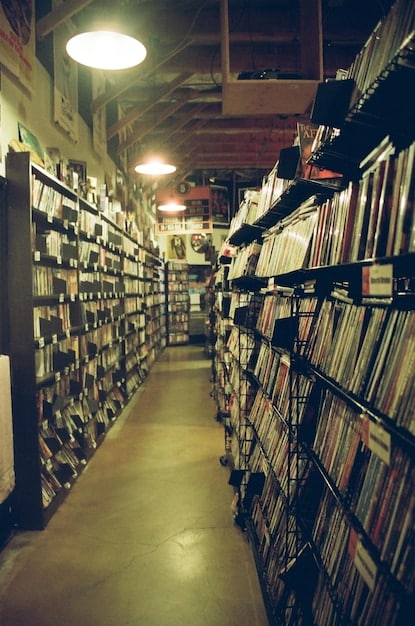The Resurgence of Vinyl Records: Why Sales Are Up 20% Among Gen Z Listeners

The surprising surge in vinyl record sales, particularly a 20% increase among Gen Z listeners, stems from a unique blend of physical ownership appeal, superior sound quality perception, and a desire for authentic, tangible music experiences in a digital age, alongside strategic marketing by artists and labels.
In an era dominated by instantaneous digital streams, the unexpected comeback of analog music formats has captivated cultural commentators. Amidst this nostalgic revival, The Resurgence of Vinyl Records: Why Sales Are Up 20% Among Gen Z Listeners stands out as a particularly intriguing phenomenon, challenging conventional wisdom about modern consumption habits. What drives this demographic, often seen as tethered to all things digital, to embrace a format decades older than themselves?
The Tangible Appeal of Vinyl in a Digital World
The digital age, while offering unparalleled convenience, has inadvertently created a hunger for the tangible. For many, music has become an ephemeral stream of data, lacking physical presence. Vinyl records, by contrast, offer a profound tactile experience.
Holding an album, admiring the cover art, reading liner notes – these are rituals that digital files simply cannot replicate. This hands-on engagement transforms listening from a passive background activity into a deliberate, immersive event. It’s a fundamental shift from consuming content to experiencing art.
Beyond the Stream: A Multisensory Experience
The allure of physical media extends beyond mere ownership; it’s about a deeper connection. Gen Z, having grown up with infinite digital options, finds novelty and value in something that requires intention and ceremony. It’s not just about the sound, but the entire process. This can be broken down into several key elements:
- Visual Aesthetics: Large album artwork provides a canvas for artistic expression that is lost on smaller digital screens.
- Tactile Engagement: The act of removing a record from its sleeve, placing it on a turntable, and dropping the needle creates a physical connection to the music.
- Ritual and Intentionality: Vinyl encourages active listening, turning a casual act into a dedicated experience, often shared with others.
- Collectibility: Limited editions, colored vinyl, and unique packaging offer a compelling reason for collectors.
The sense of anticipation built during the setup process enhances the eventual listening experience. It’s a return to a more deliberate form of consumption, contrasting sharply with the ‘skip culture’ prevalent in streaming. This intentionality helps foster a deeper appreciation for the artist’s work.
Furthermore, the “hunt” for specific records in physical stores or online adds another layer of engagement. Discovering a rare pressing or a favorite album on vinyl becomes a rewarding endeavor, fostering a sense of accomplishment and unique ownership that digital purchases rarely provide. This journey from discovery to acquisition enhances the overall value perception of the vinyl record itself.
Perceived Superior Sound Quality: Fact or Fiction?
One of the most debated aspects of vinyl’s comeback is the claim of superior sound quality. While audiophiles may point to the warmth and naturalness of analog sound, the technical reality is complex, often depending more on the mastering and pressing quality than on the format itself.
Nevertheless, a significant portion of Gen Z perceives vinyl as offering a richer, more authentic listening experience. This perception, whether entirely accurate or partly psychological, plays a crucial role in driving sales.
The “Warmth” of Analog: A Subjective Truth
Digital audio, with its pristine clarity, sometimes leaves listeners longing for an organic feel. Vinyl, with its inherent imperfections – faint crackles, surface noise – can convey a sense of ‘life’ and ‘presence’ that some find missing in digital formats. This ‘warmth’ is often cited as a primary reason for preference.
- Richer Mid-Range: Many enthusiasts describe vinyl as having a fuller, more resonant mid-range frequencies, enhancing vocals and instruments.
- Absence of Compression Artifacts: Unlike some heavily compressed digital files, well-mastered vinyl can offer a dynamic range that feels more natural and less fatiguing for the ear.
- Depth and Spatiality: Some listeners report a greater sense of depth and soundstage on vinyl, making instruments feel more distinct within the mix.
The argument isn’t always about outright technical superiority, but rather about a different kind of audio experience. It’s about a sound profile that evokes a stronger emotional response for many. This subjective ‘better’ quality often trumps objective measurements in the court of public opinion and personal enjoyment.
It’s important to note that the quality of the playback system plays a huge role. A cheap turntable with low-quality components will likely diminish any perceived sonic advantages of vinyl. However, for those willing to invest in decent equipment, the difference can be noticeable and highly satisfying, reinforcing their belief in vinyl’s superior sound.
Nostalgia’s New Wave: Gen Z Embraces Retro Charm
While Gen Z didn’t grow up with vinyl as the primary music format, they are nonetheless susceptible to the allure of nostalgia. This isn’t a direct nostalgia for their own past, but rather a romanticized view of past eras, fueled by social media, fashion trends, and a general longing for authenticity.
Vinyl embodies this retro charm perfectly, serving as a gateway to exploring music history and connecting with a perceived simpler time. It’s about participating in a cultural phenomenon that predates their digital native experience.
Connecting with a Bygone Era
The aesthetic appeal of pre-digital technology resonates strongly with a generation often immersed in screens. Vinyl offers a tangible link to a different way of living and creating, standing in stark contrast to ephemeral digital trends. This fascination with the past is evident in other areas of Gen Z culture, like vintage clothing and analog photography.
- Social Media Aesthetics: Vinyl records and turntables are often featured in aesthetically pleasing social media posts, aligning with aspirational lifestyles.
- Cultural Symbolism: Owning vinyl can symbolize an appreciation for ‘authentic’ music and a discerning taste, enhancing one’s personal brand.
- Discovery of Classics: The format encourages exploration of older music, introducing Gen Z to iconic albums they might otherwise overlook in a sea of new releases.
This “retro chic” appeal extends beyond just the object; it’s about embracing a lifestyle that values patience, artisanship, and a deeper engagement with art. It’s a form of counter-culture, a quiet rebellion against the relentless pace of digital consumption. This aspect of discovery and exploration is crucial.

The vinyl renaissance isn’t merely about buying an old format; it’s about curating an experience. It’s about creating a personal sanctuary for music listening, free from the distractions of notifications and endless scrolling. This curated experience offers a sense of control and individuality that is highly appealing.
The Influence of Artists and Marketing Strategies
The resurgence of vinyl isn’t purely organic; it’s significantly bolstered by artists and record labels actively embracing the format. Releasing albums on vinyl has become a standard practice, often accompanied by deluxe editions, unique colors, and exclusive content, making them highly desirable collector’s items.
Artists themselves play a crucial role by promoting vinyl on their social media, often showcasing their own collections, which inspires their younger fans to follow suit. This direct engagement fosters a deeper connection between artist and listener, making the physical product even more appealing.
Vinyl as a Premium Product and Collector’s Item
Labels have strategically positioned vinyl as a premium product, often at higher price points than CDs or digital downloads. This pricing strategy, coupled with limited releases and special editions, enhances its perceived value and exclusivity. For Gen Z, who value authenticity and unique experiences, this makes vinyl an attractive proposition.
- Exclusive Content: Many vinyl releases include bonus tracks, unique artwork, or special packaging not available digitally.
- Tour Merchandise: Selling vinyl at concerts creates an immediate connection between the live experience and the physical record.
- Artist Promotion: Artists often share their vinyl collections and turntable setups on social media, encouraging fan engagement.
The vinyl release schedule often involves pre-orders, building anticipation and creating a sense of urgency. This scarcity model, common in luxury goods, taps into the human desire for limited access items, driving sales before the product even hits the shelves. It transforms purchasing music from a simple transaction into an event.
Furthermore, the collectible nature of vinyl is accentuated by platforms like Discogs, which allow enthusiasts to track their collections, discover rare pressings, and even trade or sell records. This community aspect further cements vinyl’s place as more than just a listening format, but also a hobby and an investment.
Sustainability and Conscientious Consumption
While often overlooked, the environmental impact of music consumption is an increasingly relevant topic for Gen Z, a generation acutely aware of climate change. Streaming, despite its apparent ‘zero waste’ nature, has a significant carbon footprint due to server farms and massive energy consumption.
Vinyl, while not entirely without its own environmental concerns (e.g., PVC production), can be seen as a more sustainable option in certain contexts, particularly when acquired secondhand or when considered for its longevity and reusability over disposable digital streams.
Exploring the Environmental Footprint of Music
The discussion around sustainability in music is nuanced. While digital delivery avoids physical waste, the continuous energy demand of data centers and personal devices is substantial. Vinyl, when made with recycled materials or bought used, can offer a more circular economy approach to music consumption.
- Durability and Longevity: A well-cared-for vinyl record can last for decades, offering long-term value compared to fleeting digital files.
- Secondhand Market: The thriving used vinyl market promotes reuse and reduces the need for new production.
- Material Innovation: Some manufacturers are exploring more eco-friendly vinyl compounds and packaging to reduce environmental impact.
For a generation increasingly prioritizing ethical consumption, the ability to physically own and cherish media that can be repurposed or passed down aligns with values of sustainability and conscious living. This contrasts with the ‘throwaway’ nature of many digital experiences, where ownership is often merely licensing.
The debate about the “greenest” way to consume music is ongoing, but the perceived tangibility and permanence of vinyl can align more closely with a desire for less wasteful consumption. It moves away from the idea of infinite, disposable consumption towards an appreciation of finite, valuable objects.
The Social and Communitarian Aspect of Vinyl Culture
Beyond individual listening, vinyl fosters a strong sense of community. Record stores, pop-up markets, and online forums provide spaces for enthusiasts to connect, share discoveries, and discuss their passion. For Gen Z, who often navigate the complexities of online social interaction, these physical and virtual communities offer authentic connections centered around a shared interest.
This social dimension elevates vinyl from a mere product to a cultural touchstone, something that facilitates human connection and shared experiences.

Building Connections Through Shared Passion
The act of visiting a record store can be a social outing, an opportunity to browse, discover new artists, and engage with knowledgeable staff or other customers. Online, communities dedicated to vinyl collecting thrive on forums and social media, creating a global network of enthusiasts.
- Record Store Day: Annual events like Record Store Day bring communities together for exclusive releases and communal celebrations of vinyl.
- Online Forums and Groups: Dedicated online spaces allow collectors to share tips, recommend music, and discuss new releases or rare finds.
- Sharing Sessions: Vinyl encourages communal listening, where friends gather to share music and discuss artists, enhancing social bonds.
The hands-on nature of vinyl naturally lends itself to shared experiences. It’s often not just about what you’re listening to, but who you’re listening with. This communal aspect, whether in a store or at home, further enhances the overall appeal and strengthens the bond between Gen Z and this analog format.
In an increasingly isolated digital landscape, the opportunity to engage with others over a shared, tangible passion is profoundly meaningful. It offers a genuine alternative to the often superficial interactions found online, fostering deeper relationships and a sense of belonging among enthusiasts.
| Key Factor | Brief Description |
|---|---|
| 💿 Tangible Appeal | Offers a physical, collectible format in a digital-dominated world. |
| 🎶 Sound Quality | Perceived “warmth” and richer audio experience appeals to listeners. |
| 🕰️ Retro Charm | Symbolizes authenticity and connects to a romanticized past era. |
| 🤝 Community | Fosters social interaction and shared experiences among enthusiasts. |
Frequently Asked Questions About Vinyl’s Resurgence
▼
Vinyl sales are rising due to Gen Z’s desire for tangible experiences, perceived sound quality, aesthetic appeal, and the format’s role in fostering community. Artists and labels also actively promote vinyl, making it a desirable collector’s item in a digitally saturated world.
▼
The perceived superiority of vinyl sound, often described as “warm,” is subjective. While technically digital can offer higher fidelity, many listeners prefer vinyl’s analog characteristics, which can provide a fuller sound and a unique listening experience. Optimal quality depends heavily on mastering and playback equipment.
▼
Gen Z’s engagement with vinyl is not about direct nostalgia for their past, but rather a romanticized appreciation for retro culture. Vinyl embodies an authentic, anti-digital aesthetic that resonates with their desire for unique, tangible items and a connection to cultural history.
▼
Artists and labels strategically promote vinyl by releasing deluxe editions, exclusive content, and limited pressings. This makes vinyl an appealing collector’s item. Artists also showcase their vinyl on social media, influencing fans and strengthening the artists-to-listener connection.
▼
The environmental impact is complex. While vinyl production involves PVC, its longevity and the robust secondhand market promote reuse. In contrast, streaming incurs continuous energy use from data centers. For some, vinyl offers a more sustainable, long-term consumption model when compared to the ephemeral nature of digital files.
Conclusion
The surprising and robust resurgence of vinyl records, particularly the 20% sales increase among Gen Z listeners, is far from a fleeting trend. It represents a multifaceted cultural shift, reflecting a collective yearning for authenticity, tangibility, and community in an increasingly digital and ephemeral world. From the tactile pleasure of holding a physical album to the perceived warmth of analog sound, and from the allure of retro aesthetics to the strategic pushes by artists and labels, vinyl offers a holistic experience that streaming simply cannot replicate. This analog renaissance proves that even in the most technologically advanced eras, there remains a profound human desire for the tangible, the intentional, and the communitarian, ensuring vinyl’s continued spin for years to come.





